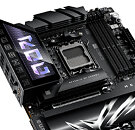Around late January, concerned owners of high-end ASUS motherboards
uploaded photo and video evidence of alleged physical damage caused by the manufacturer's PCIe "Q-Release Slim" system. Social media and forum posts showed worrying scraping and scratching on graphics card interfaces. The North American branch of ASUS responded to reports with a
public service announcement: "in our internal testing and evaluation of the extremely small number of cases reported, we found no damage to the motherboard or graphics card that would affect functionality and/or performance....However, it is important to emphasize that any type of PCIe add-in card will exhibit signs of usage and wear marking after 60 continuous insertions and removals." Rival brands have kept tabs on this sorry situation; many offer similar motherboard-mounted GPU quick release systems. Yesterday, GIGABYTE's Japanese office posted a very "on the nose" demonstration of their EZ Latch Plus design.
The AORUS Japan social media account's "Ultimate PCIe Scratch Test" video involved the repeated insertion and removal of a candidate card from a
GIGABYTE Z890 AORUS ELITE WIFI7 ICE motherboard. An anonymous employee completed one hundred cycles. Upon the experiment's conclusion, the graphics card's interface displayed zero evidence of physical deterioration. The manufacturer's Japanese AORUS branch boasted (via machine translation): "start building your PC with confidence! GIGABYTE's renowned easy DIY and ultra-durable design ensures smooth, hassle-free builds and rock-solid reliability. No more worrying about peeling golden finger contacts or scratches from metal edges." Their sarcastic delivery seemingly pokes fun at ASUS and the "troubled" Q-Release Slim system; it should be noted that it is a relatively new design. As reported back in early February, ASUS China
launched an extensive customer support/compensation program. According to user accounts, some very expensive custom GeForce RTX 50-series cards have suffered cosmetic damage on PCIe interfaces. GIGABYTE's Western web presences have joined in on the fun—the AORUS Official social media account delivered a slightly different spin on their overall message: "game on with confidence! With our renowned DIY-friendly and Ultra Durable design, you'll enjoy a smooth, hassle-free build with rock-solid reliability. No more worries about gold finger paint peeling or scratches from metal edges—our design provides complete protection for both your GPU and motherboard."














































